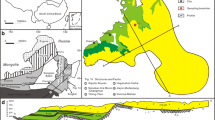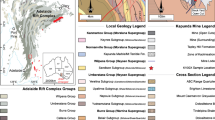Abstract
The structure, chemistry and distribution of hydrothermal alteration and weathering products of feldspars and glass in 3 samples of Yucca Mountain tuffs (GSW G4 borehole at a depth of 1531 ft (464 m) and USW GU3 borehole at 1406 ft (426 m) from the Calico Hills Formation and USW G4 at a depth of 272 ft (82.4 m) from the Topobah Springs Member) were examined by high-resolution transmission electron microscopy (HRTEM) and analytical electron microscopy (AEM). Alteration products are of interest because they may influence the form and distribution of contaminants released from the proposed high-level nuclear waste repository. Samples from the Calico Hills Formation contain alkali-bearing aluminosilicate glass and its alteration products. Zeolites appear to have formed from compositionally similar glass by recrystallization, probably under hydrothermal conditions. Crystals are fibrous and frequently no more than a few tens of nanometers in diameter. Porous aggregates of few-nanometer-diameter, poorly crystalline silica spheres (probably opal C-T) develop adjacent to corroded glass surfaces and zeolite crystals. Finely crystalline Fe-rich smectites coat etched glass surfaces, zeolites and feldspar crystals and occur within opal-like silica aggregates. Microstructures in the clay-dominated coatings and details of smectite-glass interfaces suggest that clays grow in orientations controlled by heterogeneously retreating surfaces and from constituents released at associated glass dissolution sites. The alteration assemblage also includes finely crystalline hematite, goethite, Mn-oxide films and illite formed by alteration of muscovite. The zeolitized sample contains abundant opal-like silica whereas glass in the unzeolitized sample is weathered to smectite-like clays. These differences may be attributed to hydrological and consequent geochemical factors resulting from the higher porosity of zeolitized samples. Exsolved alkali feldspar, which occurs as micron-sized crystals in the Calico Hills Formation and as phenocrysts and in the groundmass of the devitrified Topobah Springs Member, are almost unaltered. Feldspar alteration is confined to cracks and grain boundaries, where minor, poorly crystalline, Fe-bearing aluminosilicate alteration products are developed. In these tuffs, most of the porosity, permeability, high surface area and capacity to affect solution chemistry are associated with products of glass alteration.
Similar content being viewed by others
References
Bailey SW. 1988. X-ray identification of the polytypes of mica, serpentine, and chlorite. Clays Clay Miner 36:193–213.
Barker WW, Banfield JF. 1996. Biologically- versus inorganically-mediated weathering reactions: Relationships between minerals and extracellular microbial polymers in lith-obiontic communities. Chem Geol 132:55–69.
Bish DL. 1988. Smectite dehydration and stability: Applications to radioactive waste isolation at Yucca Mountain, Nevada. Los Alamos Natl Lab Report LA11023MS.
Bish DL, Aronson JL. 1993. Paleogeothermal and paleohy-drologic conditions in silica tuff from Yucca Mountain, Nevada. Clays Clay Miner 41:148–161.
Bish DL, Chipera SJ. 1989. Revised mineralogic summary of Yucca Mountain, Nevada. Los Alamos Natl Lab Report LA11497MS. 68 p.
Bish DL, Vaniman DT, Byers FM, Broxton DE. 1982. Summary of the mineralogy-petrology of tuffs of Yucca Mountain and the secondary-phase thermal stability in tuffs. Los Alamos Natl Lab Report LA9321MS.
Blacic JD, Vaniman DT, Bish DL, Duffy CJ, Gooley RC. 1986. Effects of long-term exposure of tuffs to high-level nuclear waste repository conditions. Final Report. Los Alamos Natl Lab Report LA9330MS.
Blum AE, Stillings LL. 1995. Feldspar dissolution kinetics. In: White AF, Brantley SL, Editors. Chemical weathering rates of silicate minerals. Rev Mineral 31:291–351.
Bohor BF, Triplehorn DM. 1993. Tonsteins: Altered volcanic-ash layers in coal bearing sequences. Geol Soc Am Spec Paper 285. 44 p.
Bolivar SL, Broxton DE, Bish DL, Byers FM, Carlos BH. 1989. Mineralogy-petrology studies and natural barriers at Yucca Mountain, Nevada. Nuclear waste isolation in the unsaturated zone: FOCUS '89; Las Vegas, NV; 18–21 Sep 1989. LAUR892952, CONF8909283.
Broxton DE, Bish DL, Warren RG. 1985. Distribution and chemistry of diagenetic minerals at Yucca Mountain, Nye County, Nevada. DOENBM7013292.
Broxton DE, Bish DL, Warren RG. 1987. Distribution and chemistry of diagentic minerals at Yucca Mountain, Nye County, Nevada. Clays Clay Miner 35:89–110.
Carlos BA, Bish DL, Chipera SJ. 1990. Manganese-oxide minerals in fractures of the Crater Flat Tuff in drill core USW G-4, Yucca Mountain, Nevada. Los Alamos Natl Lab Report LA11787MS. 61 p.
Carlos BA, Chipera SJ, Bish DL. 1995. Distribution and chemistry of fracture-lining minerals at Yucca Mountain, Nevada. Los Alamos Natl Lab Report LA-12977-MS. 92 p.
Carlos BA, Chipera SJ, Bish DL, Craven SJ. 1993. Fracture-lining manganese oxide minerals in silicic tuff, Yucca Mountain, Nevada, U.S.A. Chem Geol 107:47–69.
Chipera SJ, Bish DL. 1989. Quantitative X-ray diffraction analyses of samples used for sorption studies by the Isotope and Nuclear Chemistry Division, Los Alamos Natl Lab. Los Alamos Natl Lab Report LA-11669-MS. 20 p.
Coston JA, Fuller CC, Davis JA. 1995. Pb2+ and Zn2+ adsorption by a natural Al-and Fe-bearing surface coating on an aquifer sand. Geochim Cosmochim Acta 59:3535–3547.
Guthrie GD, Veblen DR. 1990. Interpreting one dimensional high-resolution transmission electron micrographs of sheet silicates by computer simulation. Am Mineral 75:276–288.
Johnstone JK, Wolfsberg K. 1980. Evaluation of tuff as a medium for a nuclear waste repository: Interim status report on the properties of tuff. Sandia Natl Lab Report: SAND80-1464. 134 p.
Spitz K, Moreno J. 1996. A practical guide to groundwater and solute transport modeling. New York: J Wiley. 461 p.
Thomas KW. 1987. Summary of sorption measurements performed with Yucca Mountain, Nevada, tuff samples and water from Well J-13. Los Alamos Natl Lab Report LA-10960-MS. 99 p.
Triay IR. 1991. Radionuclide migration as a function of mineralogy. 2nd Annu High-Level Radioactive Waste Mgmt Conf; Las Vegas, NV. cited in Carlos et al. 1993.
Triay IR, Mitchell JA, Ott MA. 1991. Radionuclide migration as a function of mineralogy. Proc. 2nd Annu High-Level Radioactive Waste Mgmt Conference; Las Vegas, NV. p 494–498.
Vaniman DT, Bish DL. 1993. Importance of zeolites in the potential high-level radioactive waste repository at Yucca Mountain, Nevada. Zeolite 93: 4th Int Conf on the Occurrence, Properties, and Utilization of Natural Zeolites; Boise, ID; 20–28 Jun 1993. LAUR932326, CONF93061002.
Author information
Authors and Affiliations
Rights and permissions
About this article
Cite this article
Banfield, J.F., Barker, W.W. Low-Temperature Alteration in Tuffs from Yucca Mountain, Nevada. Clays Clay Miner. 46, 27–37 (1998). https://doi.org/10.1346/CCMN.1998.0460104
Received:
Accepted:
Published:
Issue Date:
DOI: https://doi.org/10.1346/CCMN.1998.0460104




